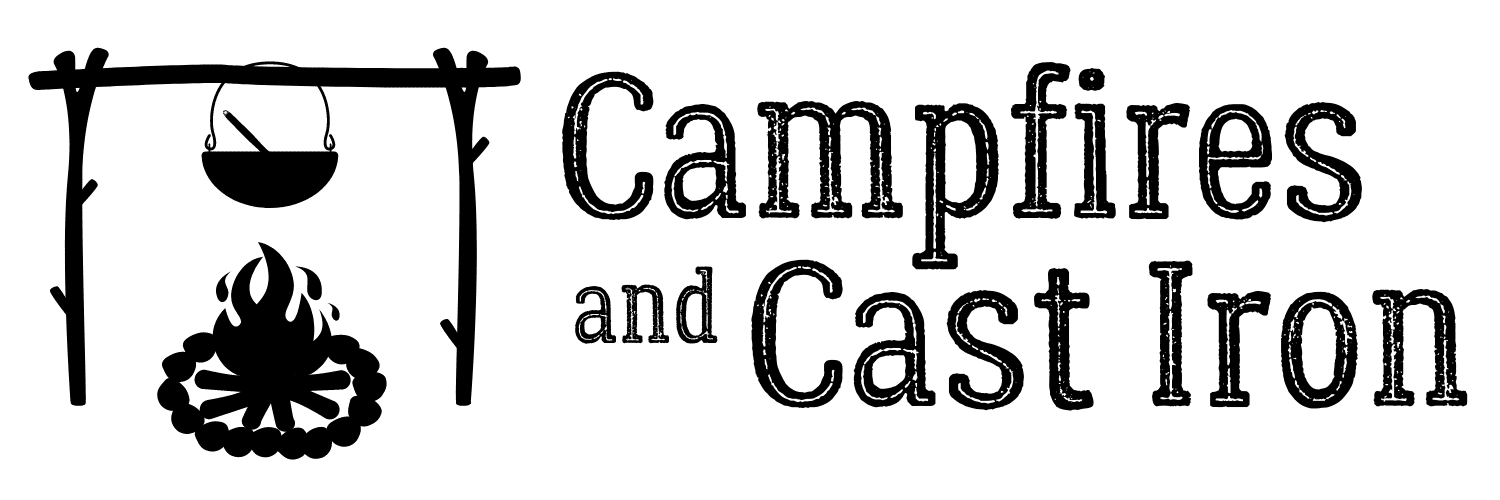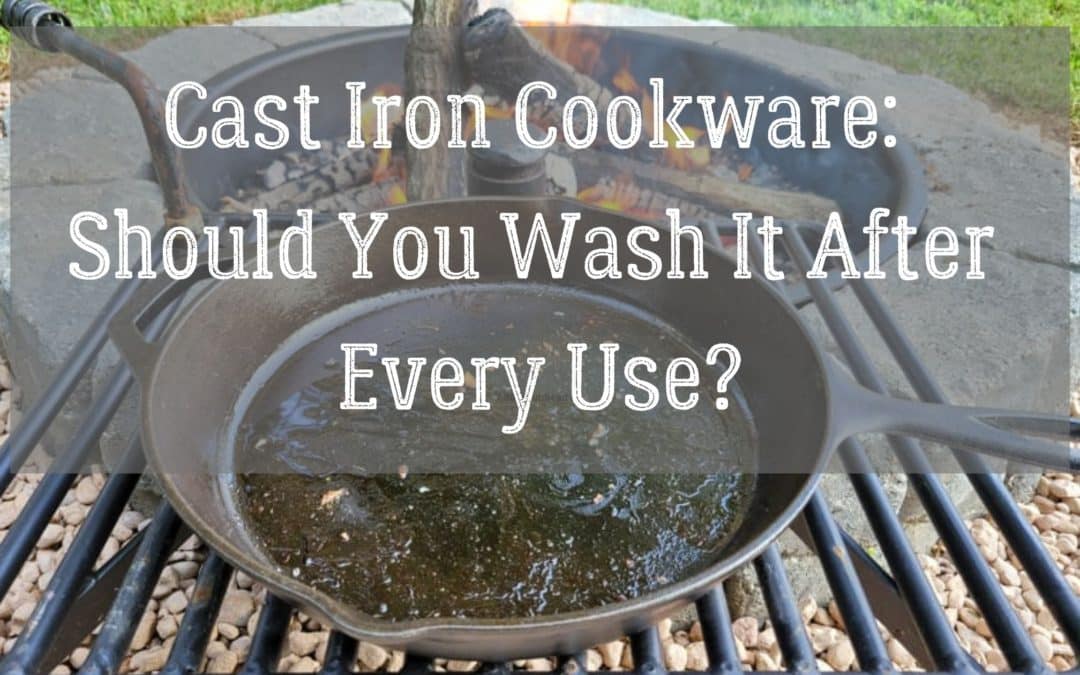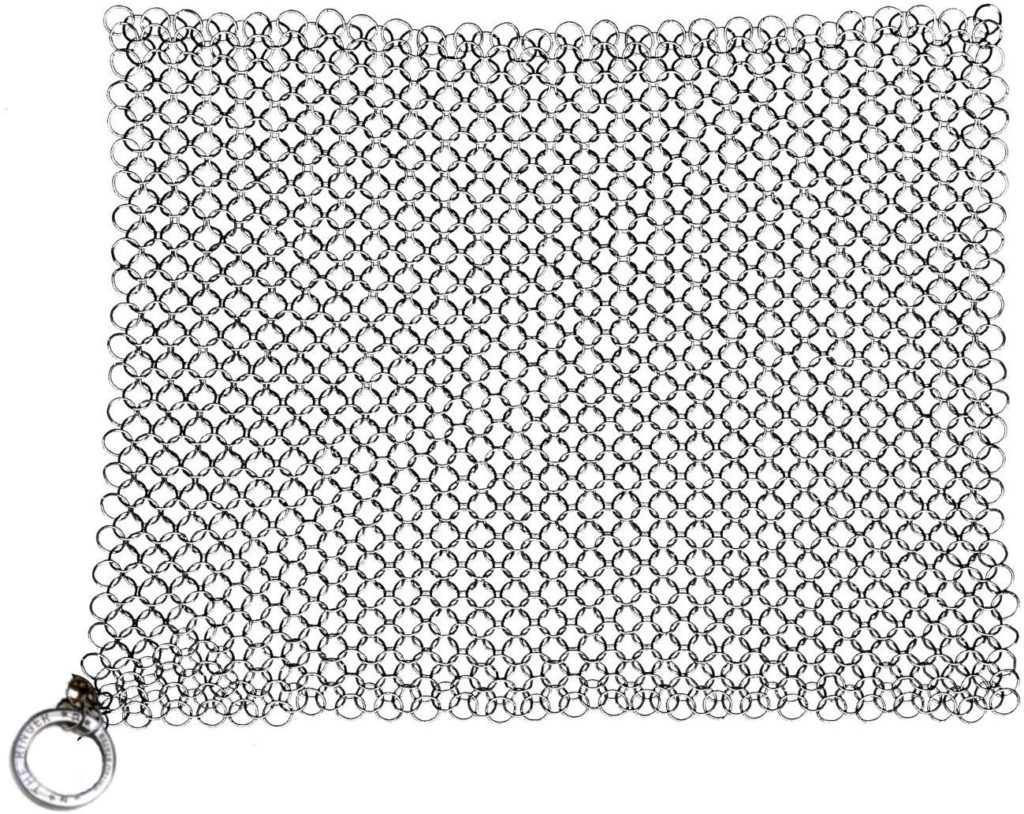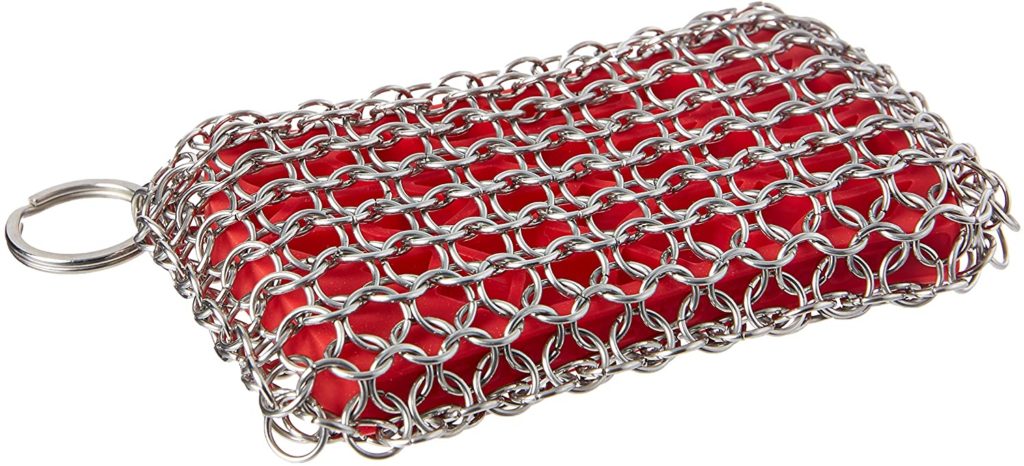Last updated on August 24th, 2022
You’ve heard it’s not a good idea to wash cast iron cookware too frequently to avoid damaging the seasoning layer. But what if your pan is dirty after cooking a meal? What if you only used your skillet for something light and it doesn’t appear greasy or dirty? Does it still need to be washed? This article will outline how frequently to wash cast iron cookware and if it’s necessary to wash it after each use.
Should you wash a cast iron skillet after each use? A cast iron skillet does not necessarily need to be washed after every use. It depends on how the pan was used. For light use without greasy food residue, it does not need to be washed. Simply wipe the skillet clean with a paper towel. If there is grease or food residue, wash the pan with hot water and a sponge. Mild soap is optional.
Keep reading below as we answer your questions about how often you should clean your cast iron cookware and which methods are best.
How Often Should Cast Iron Be Cleaned?
After each use of your cast iron pan, some form of cleaning will be necessary. Whether a quick wipe down with a paper towel will suffice or if it requires a more thorough scrub in the sink will depend on these factors: How dirty is the pan? Is there difficult-to-remove, stuck-on food? Are there any strong food odors lingering in the pan? These questions will help you determine how frequently and thoroughly your cast iron cookware should be washed.
Since cast iron is a porous material and is prone to rust and oxidation, it relies on a thin layer of oil to protect the surface from moisture in the environment. The more frequently a cast iron pan is washed, the more the oil layer is stripped away from the cooking surface. Although it’s not difficult to re-oil your skillet, the best advice for cleaning cast iron is to use the least harsh method first. Let’s look at the three recommended levels of cleaning for cast iron cookware, beginning with the most gentle.
1. Wipe Clean With A Paper Towel
If you’ve cooked a light dish with a minimal amount of oil or grease and no heavy food residue, you can simply wipe out your skillet with a clean, dry paper towel. As long as no crumbs or food residue remains, this is all you need to do.

You might notice a light, oily sheen on the cooking surface of the cast iron after wiping it with a paper towel, but this is okay. In fact, it’s a good thing. Leaving this oil on the iron helps prevent rust from forming and contributes to the non-stick properties of well-seasoned cast iron cookware.
If the pan appears dry or you don’t see the light oily sheen after wiping it clean, apply about a teaspoon of oil (grapeseed, avocado, or canola oil work well) to the cast iron. Use a paper towel or a lint-free cloth (recommended to avoid getting paper towel particles stuck to the pan) to rub a very thin layer of oil all over the inner cooking surface of the pan. Afterward, take a clean section of the towel and buff the pan to remove excess oil. Now, it’s ready to be stored until the next use.
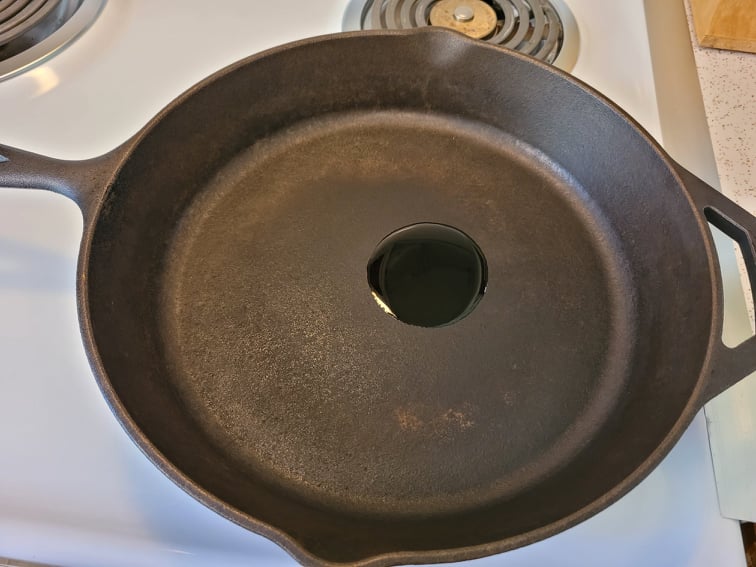
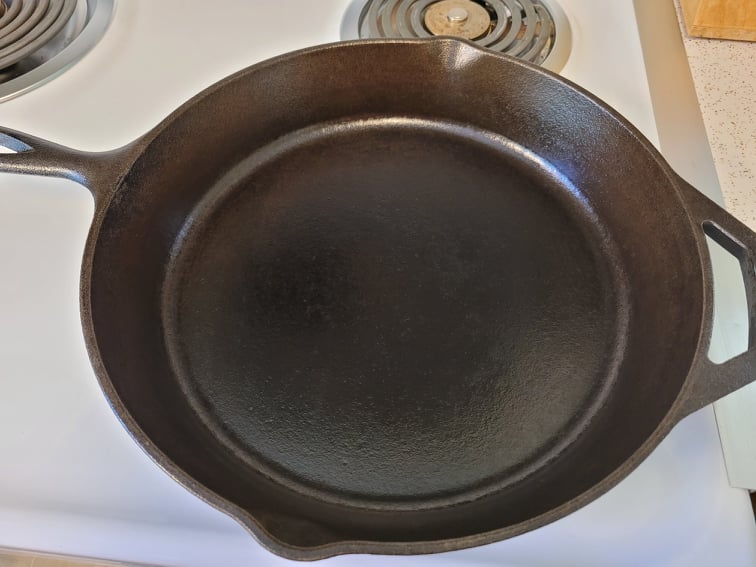
2. Rinse And Scrub
If your cast iron pan has quite a bit of grease and food residue left over after cooking, or if you’ve cooked something with a strong smell such as fish or spicy taco meat, it will require a more thorough cleaning.
Start by removing excess grease and food residue with a paper towel. Then, rinse the pan under warm water and gently scrub it with a dish brush or sponge until it is clean. Do not use steel wool or abrasive scrubbers to clean cast iron because it can damage or remove the seasoning layer. I prefer this scrub brush, and these are my favorite sponges for cleaning cast iron cookware.
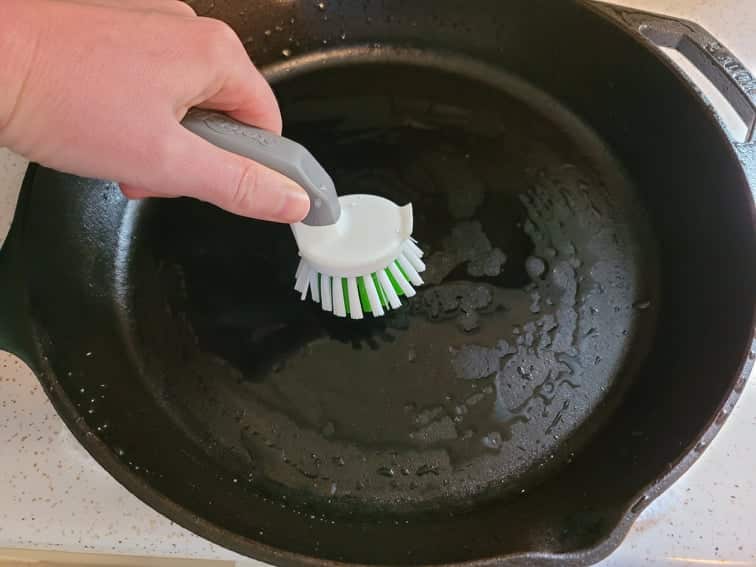
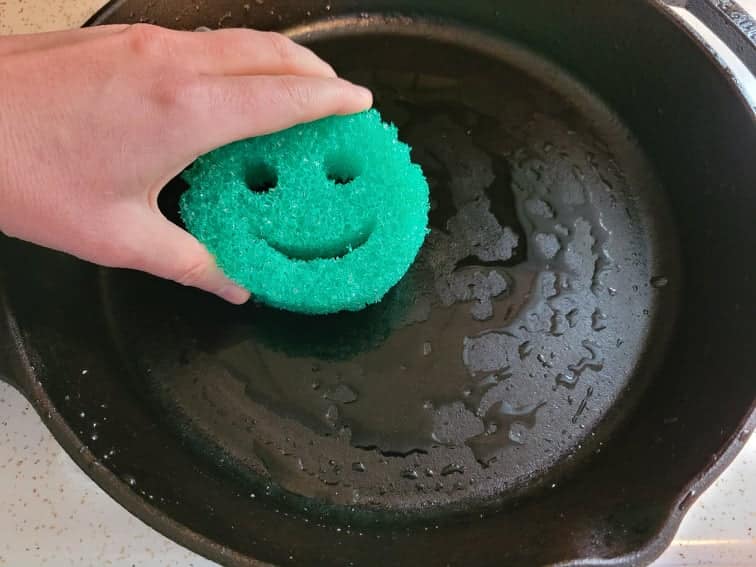
After scrubbing, rinse the pan well under warm water. Make sure to dry it thoroughly with a lint-free cloth to prevent moisture from causing rust. To be sure your cast iron pan is completely dry, it’s best to put it back on a stovetop burner or in the oven for just a few minutes on medium heat to evaporate any remaining moisture from the porous surface of the iron.
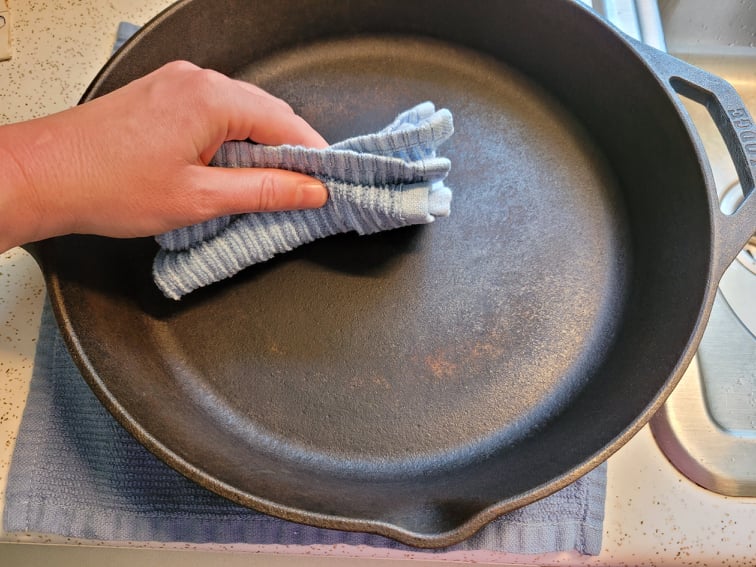
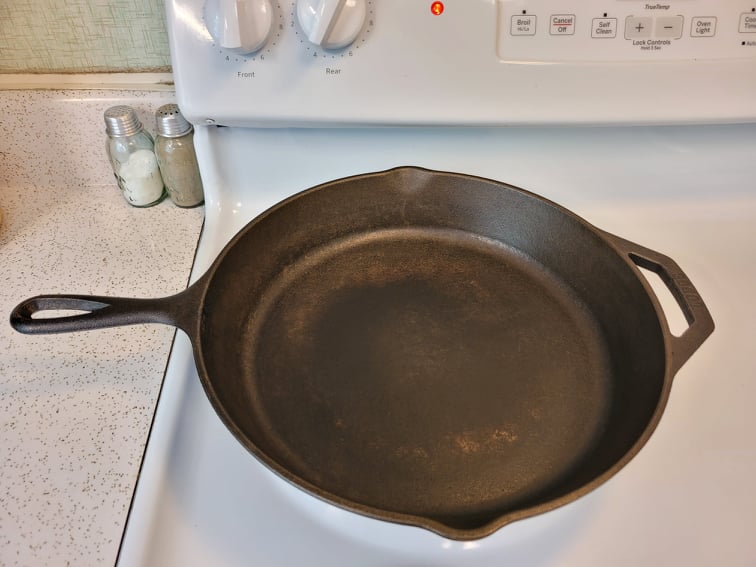
Once dry, apply about a teaspoon of oil (grapeseed, avocado, or canola) to the cast iron. Use a paper towel or a lint-free cloth to rub a very thin layer of oil all over the inner cooking surface of the pan. Afterward, take a clean section of the towel and buff the pan to remove excess oil. This will prevent it from becoming sticky and gunky.

3. Removing Difficult Food Residue
At times, you’ll have to contend with stuck or burnt-on food residue in cast iron cookware. Fortunately, there are other quick and easy ways to clean stubborn food out of cast iron pans. They’ll make short work of cleaning without damaging the seasoning layer. Let’s look at how to use the boiling water method, salt scrub method, and discover other cast iron-friendly cleaning tools you can safely use on your skillet.
Boiling Water Method
Stubborn, stuck-on food can easily be removed from cast iron by boiling water in the pan. Just fill the pan with water to a level above the food residue and heat it to boiling on the stovetop. Let it boil just for a minute or two, then remove it from the heat. Let it cool for another couple of minutes, then carefully use a scraping tool or scrub brush to clean the pan.
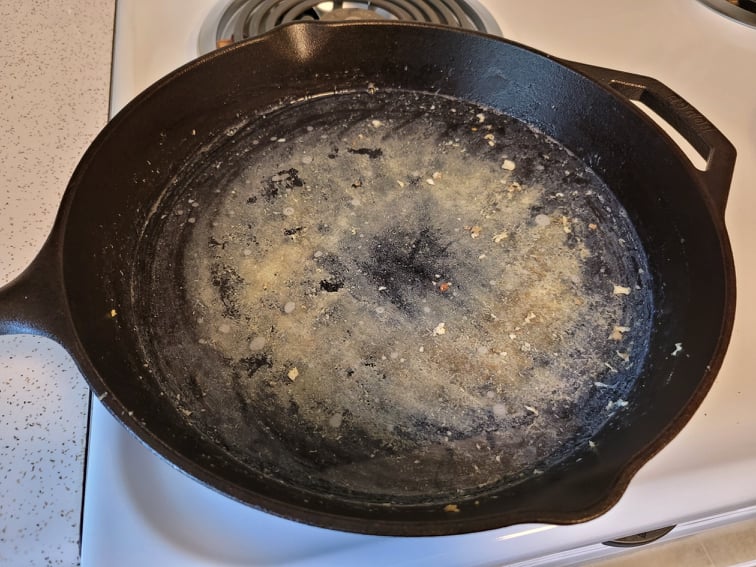
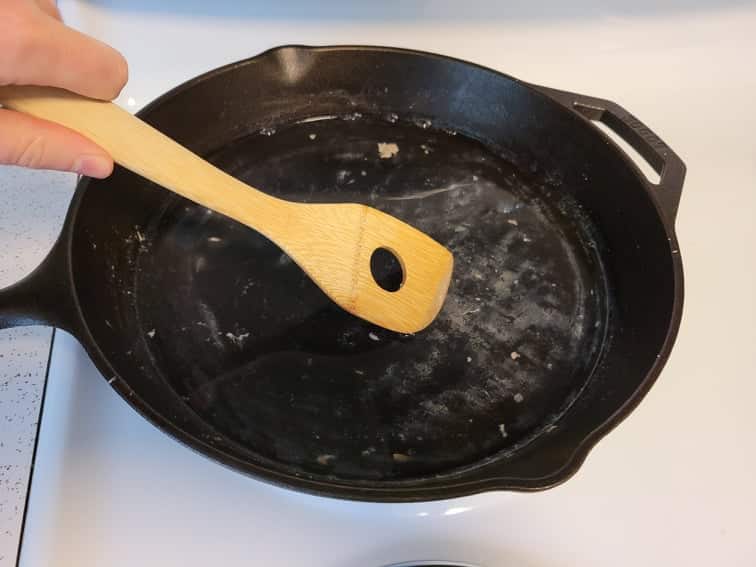
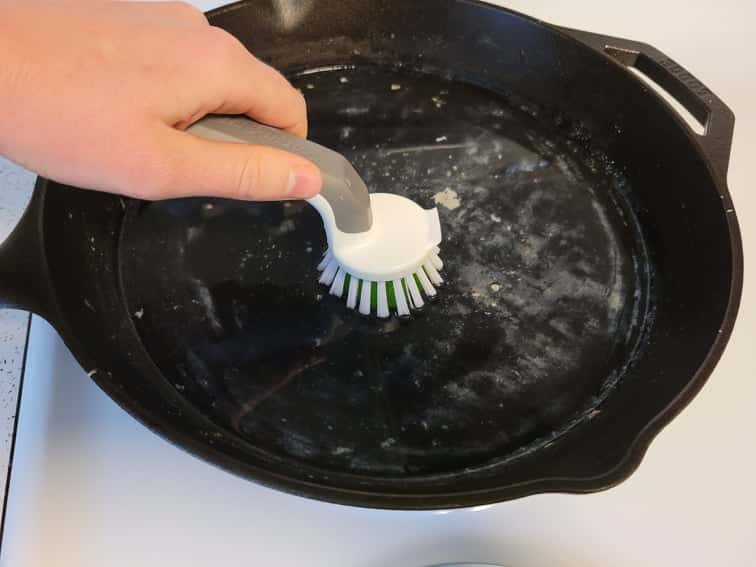
Make sure to thoroughly dry and lightly oil the cast iron as previously described above to protect it from moisture and rust.
Salt Scrub Method
Another easy way to clean stubborn bits of food from cast iron pans is with a salt scrub. Pour about a cup of coarse-grain salt into the pan while it is still warm. With paper towels or a folded washcloth, scrub the pan until any food residue is removed. Then, wipe the salt out and rinse the pan well, making sure not to leave any salt grains behind. Thoroughly dry and lightly oil the pan before storing it.
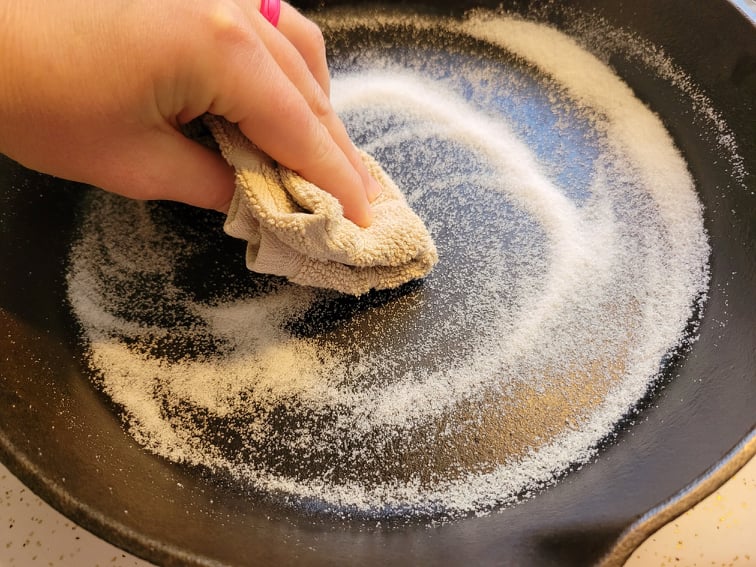
Cast Iron Cleaning Tools
There are a few specially designed tools that are super helpful for cleaning cast iron cookware. Let’s take a look at what they are and how they work.
Chainmail Scrubbers
A chainmail scrubber is a scouring device made of several small metal rings interlinked together to form a mesh, usually in a square or rectangular pattern.
Chainmail scrubbers are known for their ability to remove stuck or burnt-on food residue from cast iron without damaging the seasoning layer. Many cast iron cookware manufacturing companies promote the use of chainmail scrubbers to routinely clean pans and help improve the seasoning.
According to this instructional article from Field Company, cleaning your cast iron pan with a chainmail scrubber gently scuffs the seasoning layer and actually gives the new seasoning a slightly rough surface to bond to. By repeating this procedure over time, you are helping prepare your cast iron to accept new layers of seasoning.

Pan Scraper
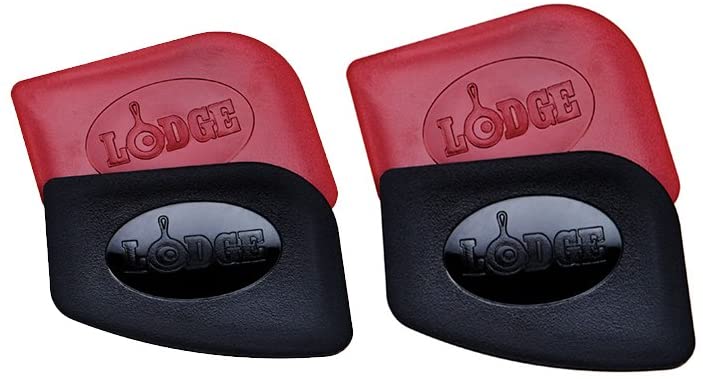
Typically made from nylon or polycarbonate material, these pan scrapers have differently shaped and sized edges to help remove stuck-on food from the bottom, sides, and edges of cookware. They are quite strong and durable, yet the material does not scratch or damage cast iron seasoning. Pan scrapers are a must-have in my kitchen!
Nylon Bristle Brush
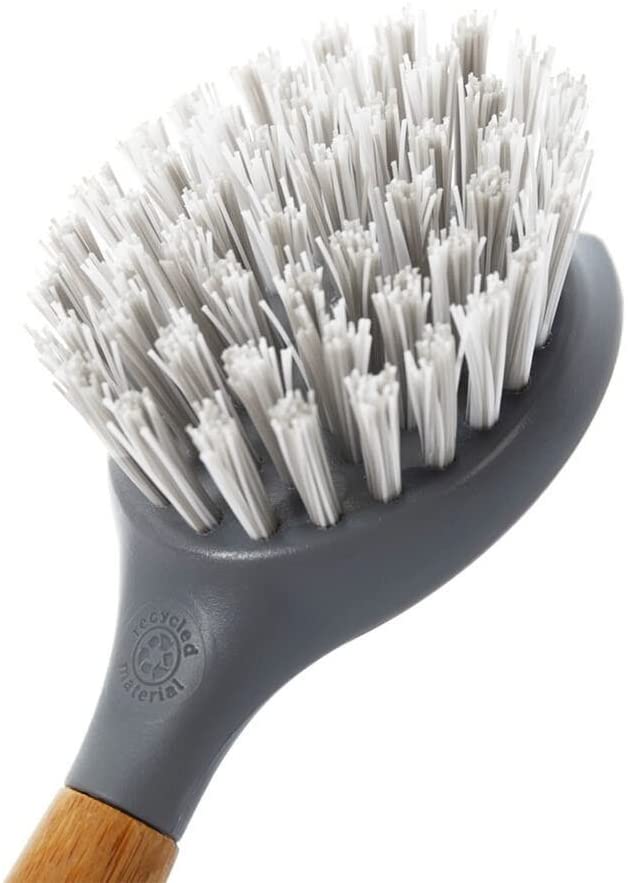
Nylon bristle dish brushes are effective for scrubbing away food and grease, but gentle on your cast iron’s seasoning layer. While there are several shapes, styles, and stiffness levels of dish brushes on the market, it is recommended to use one with stiff bristles for better cleaning ability.
Polymer Scrubber
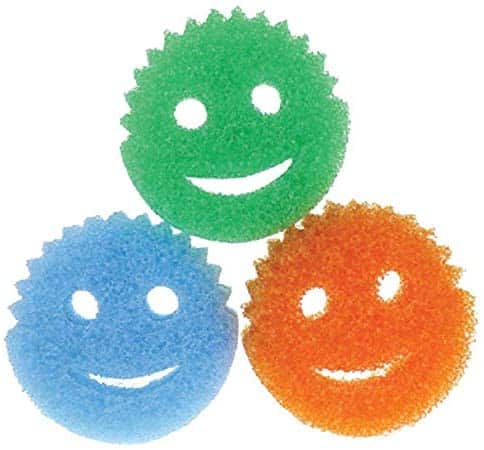
These scrubbers are made from a special synthetic material that does an excellent job of removing food residue while not damaging the cast iron’s seasoning. The most well-known polymer scrubber is probably the Scrub Daddy brand. I use these regularly on all of my cast iron cookware and I’m always pleased with how easy it is to clean my skillets with them.
The best part about these scrubbers is that they change firmness based on water temperature. If you’re using cold water, the scrubber is a more firm texture. This is great for heavy-duty scouring. In warm water, the scrubber softens. I often use a combination of the firm scrubber texture for the initial cleaning of my cast iron, then the softer texture to finish washing it.
Should I Use Soap To Kill Bacteria?
Many people are hesitant to use cast iron cookware due to the myth that you can’t use soap to clean and disinfect it. So, is this true, or not? This answer is quite divisive among cast iron users. Honestly, you could make a case either way. Let’s take a look at 1) Why it’s okay to use soap to clean your pan, and 2) Why it isn’t really necessary.
Using Soap On Cast Iron Isn’t As Bad As You Think
The truth is, yes, you can use soap when washing your skillet. Several years ago, when dish soap was lye-based, it was too harsh to be used on cast iron and would destroy the seasoning layer.
Today’s modern dish soaps are much gentler and are safe to use in small amounts on cast iron cookware without removing the seasoning. So, if you choose to use a little bit of soap, that’s perfectly fine. Just re-oil your pan and you’ll be good to go! Still not sure about the soap? Check out what the pros at Lodge Cast Iron have to say.
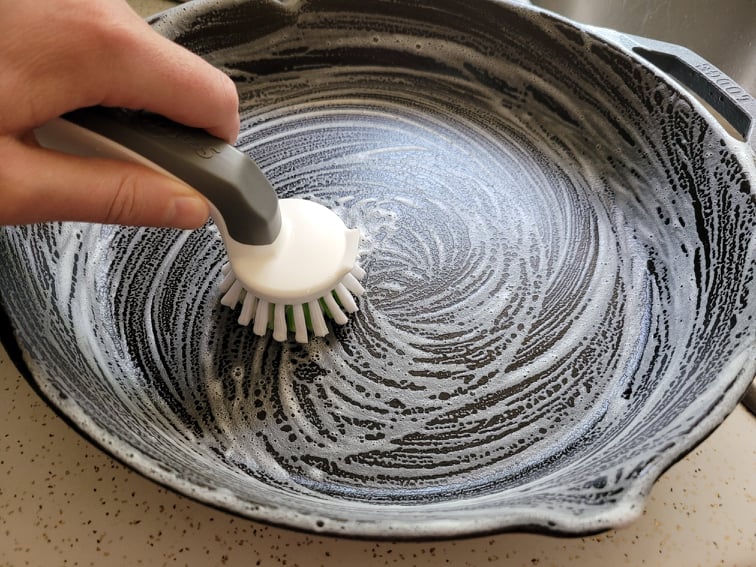
Why Using Soap To Clean Cast Iron Isn’t Necessary
You’re also completely justified if you choose not to use soap on your cast iron. In fact, this is the more popular opinion and it’s been done this way for decades.
Here’s why using soap to disinfect cast iron is not necessary: In the process of cleaning your cookware, you’ll be heating it once to dry it. If you choose to re-season after washing, you’ll be heating your pan again at a high temperature (well over 350 degrees). If you choose not to re-season your pan after washing it, pre-heat it well before cooking. This exposure to high heat for several minutes will be more than enough to kill any bacteria on the pan.
Need more proof? Check out this article, Are Cast Iron Pans Sanitary? The Science Behind The Answer to see the results of my interesting experiment!
Do I Need To Re-Season My Cast Iron After Washing It?
A cast iron pan does not necessarily need to be re-seasoned after every wash. If your pan is new, the seasoning layer has recently been damaged or stripped, or it has been scrubbed vigorously with soap, it’s a good idea to fully re-season your pan after washing it. Check out my seasoning article for a full tutorial on how to properly season cast iron cookware.
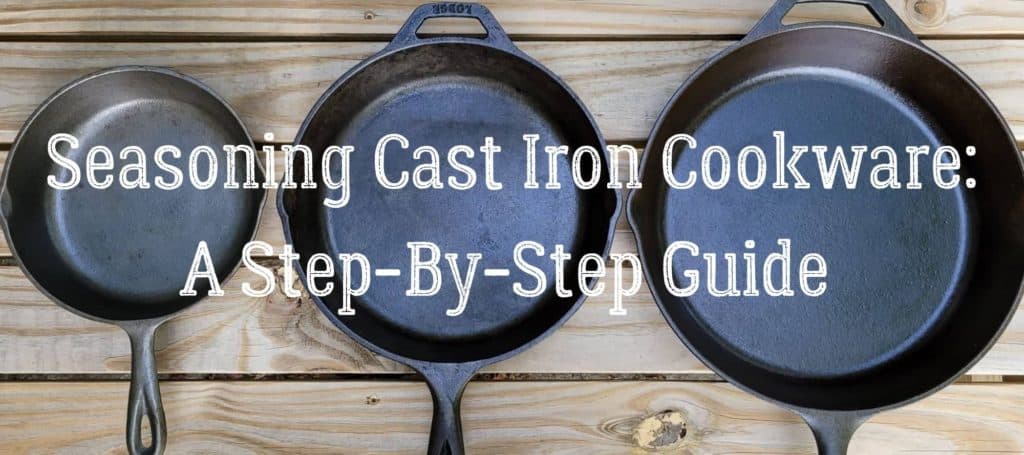
If you’ve simply wiped your cast iron clean with a paper towel or done a light scrub and rinsed it with water, you probably won’t need to re-season. After thoroughly drying your pan, just use a paper towel or lint-free cloth to rub a very thin layer of oil all over the inner cooking surface, then buff the oil off. It will be ready to be stored until the next use.
And that’s it! Your trusty cast iron cookware is clean and ready to provide many more years of delicious meals.
Now that you know how to clean and care for your cast iron, it’s time to start cooking! Be sure to check out the Recipes section of the blog for step-by-step camping and outdoor cooking recipe instructions and tasty inspiration.
This post may contain affiliate links. This means if you click on a link and make a purchase, I will receive a small commission, at no cost to you, that makes it possible for me to keep the Campfires and Cast Iron site up and running. Please see our disclosure policy for details.
